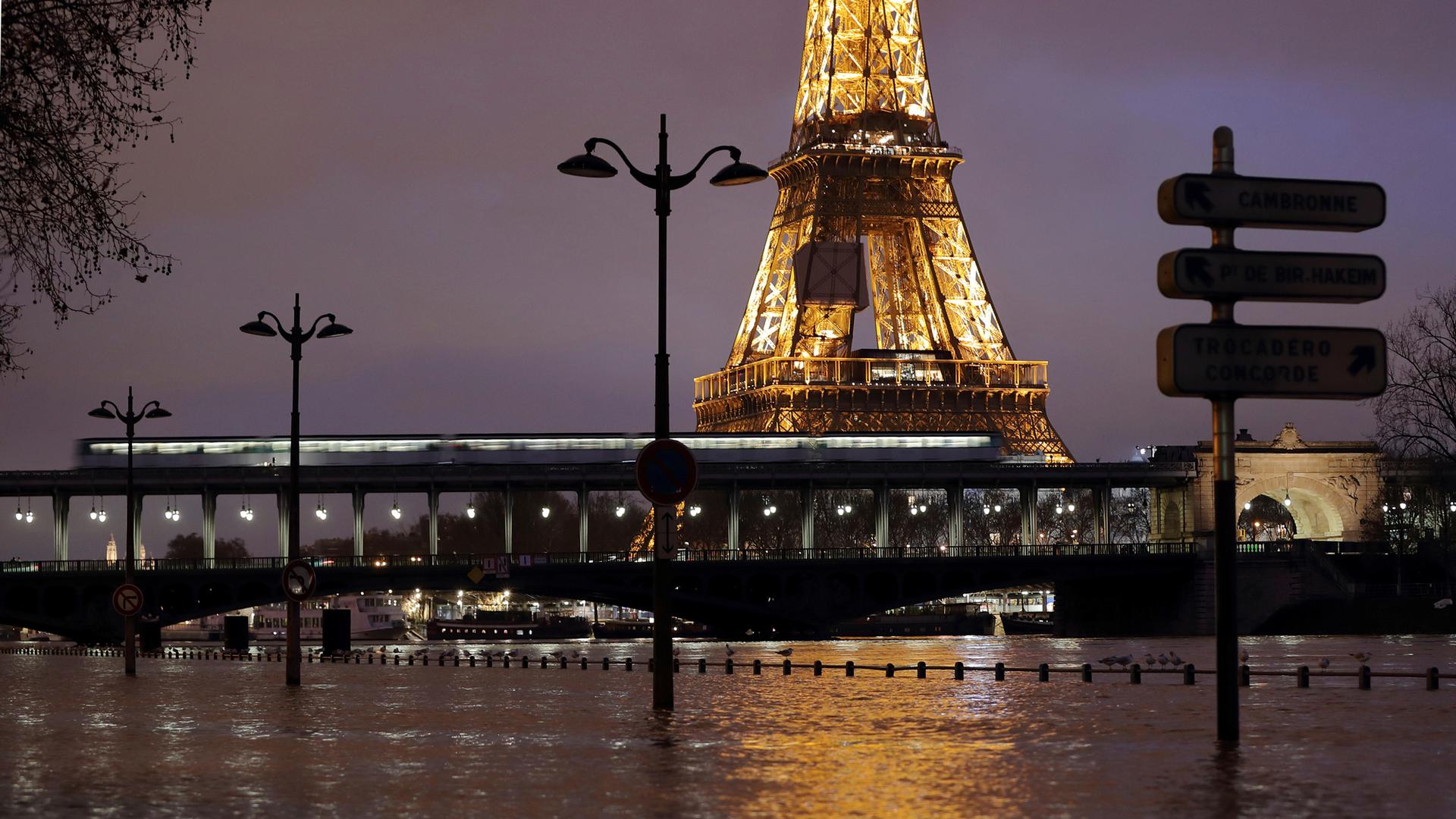Nearly 1,500 evacuated in Paris region as rising Seine poses flood risk
A view shows the flooded banks of the Seine River and the Eiffel Tower.
The swollen Seine peaked Monday at more than 19 feet above its normal level, leaving a lengthy mop-up job for Parisians after days of rising waters that have put the soggy city on alert.
The river rose to 19.2 feet early Monday, causing continued headaches for commuters as well as people living near its overflowing banks.
The Vigicrues flooding agency said the river would stay at its current level throughout the day before beginning to recede Tuesday.
"It's been a gradual rise, so you can't really call it a 'peak' — we prefer to say it has plateaued," said Rachel Puechberty, a spokeswoman for the agency.
Light rain is forecast for Monday but it is not expected to push the Seine higher, though water levels are likely to stay high for at least a week, Puechberty said.
Around 1,500 people have been evacuated from their homes in the greater Paris region, according to police, while 1,900 households have lost electricity.
Tourists also suffered with the capital's Bateaux Mouches river cruise boats out of service, and only emergency services authorized to navigate the Seine.
The river did not quite reach the 2016 high of more than 20 feet, when priceless artworks had to be evacuated from the Louvre.
But the world's most visited museum was still on alert, along with the Musee d'Orsay and Orangerie galleries, with the lower level of the Louvre's Islamic arts wing closed to visitors.
Slow clean-up expected
The Zouave, a statue of an Algerian French army soldier from the Crimean War that has guarded the river at the Pont d'Alma bridge in central Paris since 1910, was drenched up to the thighs in the muddy waters.
"Fluctuat nec mergitur (tossed but not sunk) but it's cooold," the Zouave statue tweeted from an account set up in its name by an anonymous admirer, using the city's Latin motto.
Police again warned people against bathing or canoeing in the swollen river, saying it was "forbidden and extremely dangerous."
Even once the water levels start to recede officials say it will be a slow process, as much of the ground in northern France is already waterlogged.
"If we're talking about things getting completely back to normal, that's going to take weeks," said Jerome Goellner, regional head of environmental services.
Questions were turning to the potential damage to buildings and infrastructure that have been submerged since the water started rising in early January.
The December-January period is now the third wettest on record since data collection began in 1900, according to France's meteorological service.
A main commuter line, the RER C, has halted service at Paris stops until at least February 5, with officials announcing on Twitter that a 10th pump had been installed to remove water from the flooded tracks.
Some expressways that run alongside the Seine have also been closed.
But fears of flooding like that seen in 1910, which saw the Seine rise to more than 28 feet and shut down much of Paris's basic infrastructure, appear unfounded.
11 areas still on alert
In the city centre, the Seine flows through a deep channel, limiting the potential flooding damage.
But several areas on the outskirts were under water, including the southern suburb of Villeneuve-Saint-Georges, where some residents were getting around by boat and dozens have been evacuated from their homes.
Elsewhere in France, 11 departments were still on flood alert as of Monday.
Downstream from Paris, water levels in some areas have surpassed those of 2016.
And upstream, Michel, a florist in Crosne, about 12 miles southeast of the capital, said "it's still rising, more and more — we haven't reached a peak and it's starting to get a little annoying".
On the island of Migneaux to the west of Paris, "everyone is getting around by boat," said local Serge Matikhin.
"The mood is still good, we are used to it — in 20 years we are on our eighth or ninth flood," he said.
by Clare Byrne/AFP
The story you just read is accessible and free to all because thousands of listeners and readers contribute to our nonprofit newsroom. We go deep to bring you the human-centered international reporting that you know you can trust. To do this work and to do it well, we rely on the support of our listeners. If you appreciated our coverage this year, if there was a story that made you pause or a song that moved you, would you consider making a gift to sustain our work through 2024 and beyond?
